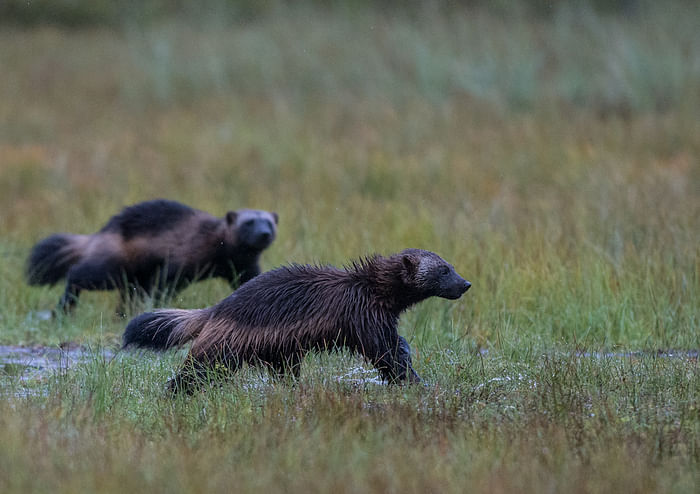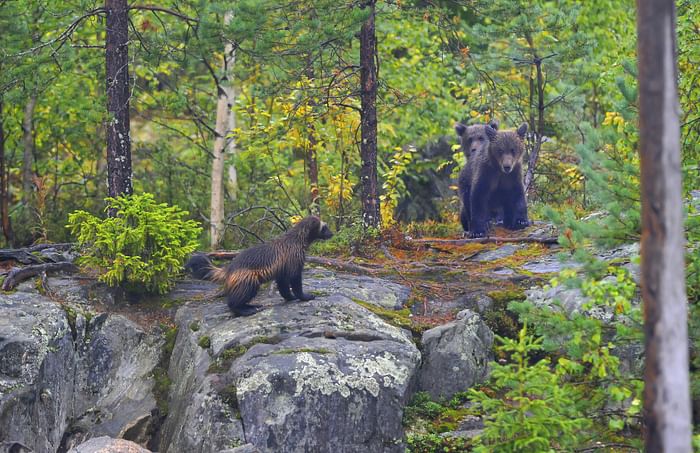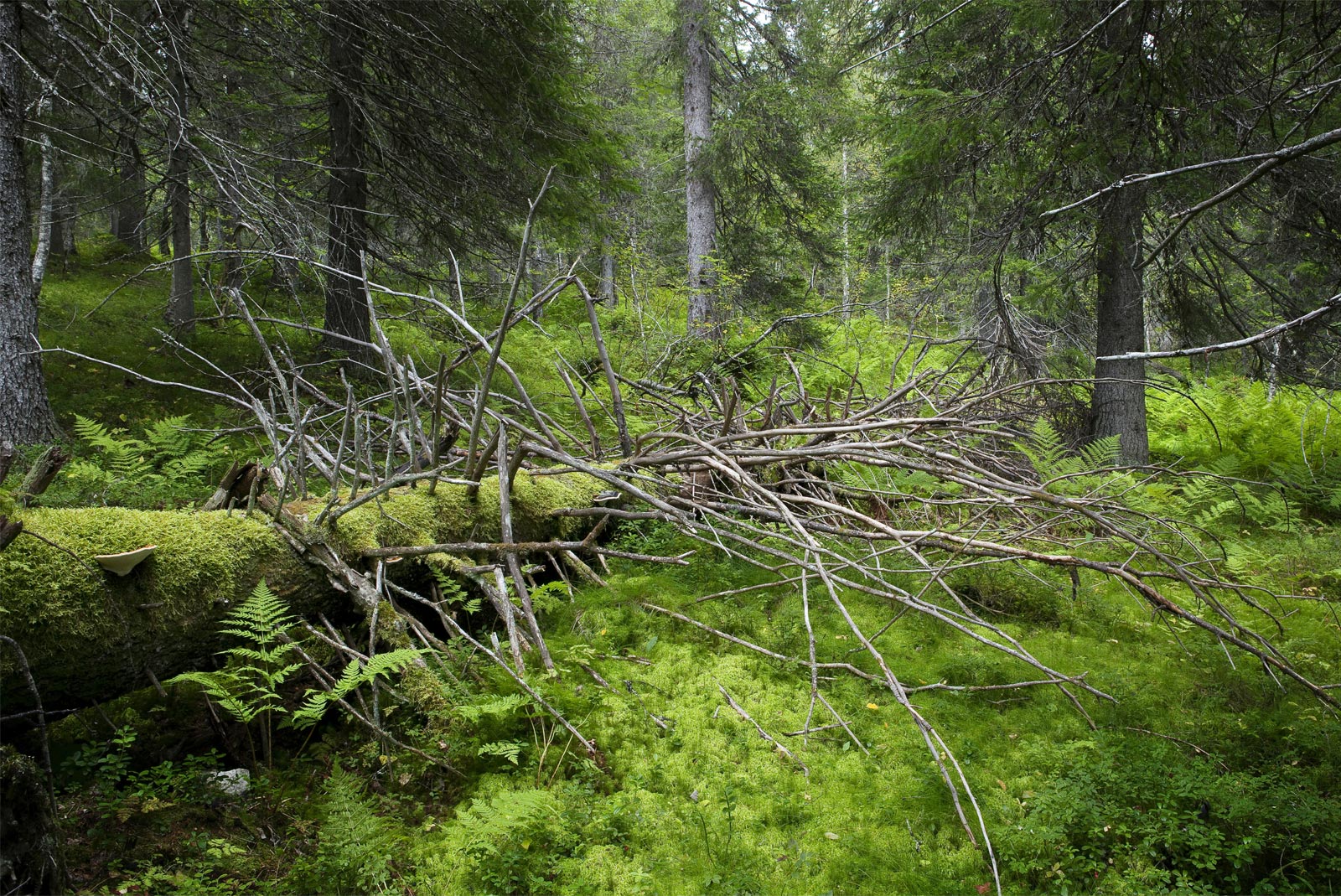Programme description
April - May In April there is still a very good chance of observing and photographing the wolverines on snow. Due to the size of the wolverine, the frost and hard snow brought about by the low temperatures will help it move more easily. Both wolverine and bears become more active from the beginning of April on wards, and can been seen moving around the snow and foraging in the early and late hours of the daytime. Chances for wolverine are 70-95 percent.
The abundance of snow creates a unique image and the perfect background on which to photograph the wild animals. The reflectivity of the snow allows shooting past the hours of daylight and also softens the light on the animal. Photographing the predators on the snow is popular due to the contrasting colours of landscape and animal, and although most years the snow will remain till the beginning of May, this may change as every year has climatic variation.
When the snow has thawed it is possible to photograph the wolverine with its reflection in the calm ponds, and the lush vegetation of late spring and summer make for some beautiful images. In May it is possible to witness cubs of wolverine when they visit in the hide area. But more often adult wolverines pick-up food for cubs, which are hiding in the wilds.
June – August The transition into summer creates new possibilities for Wolverine photography, most notably the mid-summer sun creating almost 24 hours of light available for photography. This means photographic opportunities are almost endless with regard to the amount of daylight.
Along with the extended daylight hours, summer also brings new photographic opportunities within the Boreal landscape, where the landscape is green and lush of vegetation. Swamps are carpeted with the iconic flowering cotton grass in June and July, making dramatic images possible from hides such as those on the swamps.
During summer, adult wolverines are busy foraging for food to feed their cubs, so feeding trips are regular. The probability of observing wolverine during these months is between 70-95%. Eye level windows have been installed in hides 11,15,17-25. These windows offer photographers a unique
opportunity to achieve an intimate eye level perspective with wolverine as well as other animals.
September – October The activity levels in autumn are at a similar or higher level to the previous months however autumn brings new possibilities for photographers in terms of autumnal colours and scenery.
The swamps are now changing colour from green to orange and red producing warm autumnal tones. During autumn, young wolverine may also be
present and visible alone as they learn to forage independently from their parents.
Reflections are possible during September on the lake hides 1-6, and 21-25 where photographers can incorporate the autumn landscape into images with wolverine. Every year is different in terms of changes in vegetation colour, but the best time to capture the most vibrant autumn colours is in mid-September. Autumn colours on ground is possible to see throughout September, but the best autumn colours on ground is after mid-September all the way throughout October or until the snow. In the end of September is possible to have first snow, but more common it is in October.
The aurora season gets underway in September, and the darker nights allow photographers to capture this spectacle from north facing hides. In Autumn probability to see wolverine is from 80 up to 95 percent. In October we have 5 hides to use; 21, 22 23, 24 and 25, so animals will focus better on the hide area. In October it is possible to stay in hide all day and night, in autumn wolverines can be active also during the daytime.
WOLF At Wild Brown Bear wolves are also present year round. However, due to their large territory size and behavioural characteristics they are more elusive than the Bear or Wolverine. Spring and Autumn tend to be the most effective seasons for viewing the wolves. If the conditions are right it is even possible to see wolves alongside the other apex predators in the area; the wolverine and the bear.
Over recent years individual wolves from a local pack have been seen to frequent the area, usually the wolves travel individually to cover ground as a pack more easily, however, in the winter months it is more common for wolves to travel together as it makes for easier work travelling through the snow as a group.
Detailed programme
Day 1. Timetable and info of wolverine,, hides
Info start in Bear Centre auditorium.
April
at 4pm Info, after that a short walk to the hides (500-900 meters). At the end of September the departure time to the hides can be made earlier according to movement of bears.
at 8am Return from the hides.
May - 15th August
at 5pm Info, after that a short walk to the hides (500-900 meters).
at 7am Return from the hides.
16th August -September- October
at 4pm Info, after that a short walk to the hides (500-900 meters). at at 8am Return from the hides.
Timetable October
at 3pm Info, after that a short walk to the hides (500-900 meters). at 8am Return from the hides.

Included in this programme
Snack's package for trip Bear night includes snacks that contains food, drink and utensils. Snack-packs contain thermos flasks of hot water that can be mixed with tea or coffee. Snacks are packed in backpacks that everyone carries themselves to the hide and back.
Personal snacks and drinks are allowed if you wish, only alcohol is forbidden. When taking your own extra snacks, simple snacks are recommended and should be taken into account that the packaging doesn’t rustle as this may scare bears.
You will need
Temperatures
April In the beginning of April temperatures at night are between -5 and -20 and by day are between -5 and +5 degrees. In the end of April temperatures at night are between -5 and +5 and by day between 0 and +5 degrees.
Light In mid-April the sun sets in the evening at around 8.40 and rises about 5.30 am.
Clothing and equipment There are winter sleeping bags provided in the hides. It is recommended to sit in the sleeping bag placed on the chair. This will help you remain warm and be able to photograph comfortably at the same time. Because the weather is cold it is important to bring warm clothing including a warm hat, warm gloves, woolen socks and moisture-resistant footwear.
May
In the beginning of May temperatures at night are about zero and by day between +5 and +10 degrees. In the end of May temperatures at night are between +5 and +10 and by day between +10 and +20 degrees.
June-July-August
In June temperatures at night are between +5 and +10 and by day between +10 and +25 degrees.
In July temperatures at night are between +5 and +15 and by day between +10 and +25 degrees. In August temperatures at night are between +5 and +10 and by day between +10 and +20 degrees.
September-October
In the beginning of September temperatures at night are between 0 and +5 and by day between +5 and +15 degrees. In the end of September temperatures at night are between -5 and +5 and by day between +5 and +10 degrees.
Clothing and equipment
May, September, October There are sleeping bags in the hides. It is advisable to put the sleeping bag on the chair and sit inside the sleeping bag with socks, this way you will stay warm and you will be able to photograph at the same time. Because the temperature is cooler it is good to bring warm clothing, warm hat, warm gloves, woolen socks and moisture-resistant footwear.
June-July-August In June, July and the beginning of August the hides can be hot, therefore shorts and t-shirts are suitable for clothing. By the end of August there may already be cooler nights when long-sleeved shirts and long trousers are suitable clothing. The insects are not a problem in the hides so there is no need for use of insect repellant. Avoid using insect repellants.
Good to know
Notice; we cannot guarantee to see wolverines depend of possibilities is 60-90%. Please note that is not allowed to smoke or drink alcohol at the hide.
Tips for photographing in snow and cold
-During snowfall a small air blower and lens cloth can be used to remove snowflakes and water residue from the lens. -When temperature is below zero the humidity of your breath may fog up the camera viewfinder. Try to breathe away from the camera, or use
other means to prevent misting of the lens such as placing a scarf in front of your mouth. - Cold weather drains batteries at a faster rate, so keep the batteries warm. It is important to bring spare batteries to the hide. - When returning from the hides, the humidity of air may condense in the camera when brought indoors. It is strongly advised to bring the camera indoors for example inside of a closed bag, wrapped coat or airless plastic bag. This way the inside of the bag allows the camera to warm indoors for 1-2 hours. The memory card can be removed outdoors.








Ask for more information
BEAR CENTRE


